Dinosaur Park Formation
| Dinosaur Park Formation | ||
|---|---|---|
Ma | ||
Approximate paleocoordinates 56°24′N 75°48′W / 56.4°N 75.8°W | | |
| Region | ||
| Country | ||
| Extent | Western Canadian Sedimentary Basin | |
| Type section | ||
| Named for | Dinosaur Provincial Park | |
| Named by | Eberth, D.A. and Hamblin, A.P.[1][2] | |
| Year defined | 1993 | |
The Dinosaur Park Formation is the uppermost member of the
The Dinosaur Park Formation contains dense concentrations of dinosaur skeletons, both articulated and disarticulated, which are often found with preserved remains of soft tissues. Remains of other animals such as fish, turtles, and crocodilians, as well as plant remains, are also abundant.[5] The formation has been named after Dinosaur Provincial Park, a UNESCO World Heritage Site where the formation is well exposed in the badlands that flank the Red Deer River.[2]
Geological setting

The Dinosaur Park Formation is composed of sediments that were derived from the erosion of the mountains to the west. It was deposited on an alluvial to coastal plain by river systems that flowed eastward and southeastward to the Bearpaw Sea, a large inland sea that was part of the Western Interior Seaway. That sea gradually inundated the adjacent coastal plain, depositing the marine shales of the Bearpaw Formation on top of the Dinosaur Park Formation.[4]
The Dinosaur Park Formation is about 70 metres (230 ft) thick at Dinosaur Park. The lower portion of the formation was laid down in fluvial
The sediments of the Dinosaur Park Formation are similar to those of the underlying
Biostratigraphy
The Dinosaur Park Formation can be divided into at least two distinct faunas. The lower part of the formation is characterized by the abundance of
The timeline below follows a synthesis presented by Fowler (2017)[9] with additional information from Arbour et al. 2009,[10] Evans et al. 2009, and Penkalski, 2013.[11] Megaherbivore Assemblage Zones (MAZ) follow data presented by Mallon et al., 2012.[12]

Amphibians
Remains of the following amphibians have been found in the formation:[13]
Albanerpetontidae (extinct, salamander-like amphibians)
- Albanerpeton gracilis
- Habrosaurus prodilatus
- Lisserpeton
- Opisthotriton kayi
- Scapherpeton tectum
- unnamed caudatan
- Two indeterminate caudatans
- Two unnamed salientans
- Tyrrellbatrachus brinkmani[14]
- Hensonbatrachus kermiti[15]
Dinosaurs
Remains of the following dinosaurs have been found in the formation:[10][16]
Ornithischians
Remains of the following ornithischians have been found in the formation:[17]
Ankylosaurs
Ankylosaurs from the Dinosaur Park Formation
| ||||||
|---|---|---|---|---|---|---|
| Genus | Species | Location | Stratigraphic position | Material | Notes | Images |
| Anodontosaurus | A. inceptus | Middle, 75.6 Ma ago | [Two] skulls with teeth, mandible, partially prepared skeleton, both cervical half-rings, and osteoderms.[18] | An ankylosaurid
|
 | |
| Dyoplosaurus | D. acutosquameus | Lower, 76.5 Ma ago[10] | A partial skull and skeleton including pelvis, tail, and hindlimb with pes, and osteoderms.[18] | An ankylosaurine ankylosaurid | 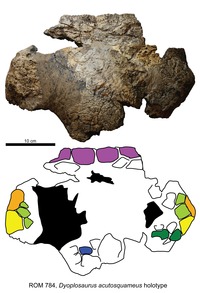 | |
| Edmontonia | E. rugosidens | Lower, 76.5-75.9 Ma ago[10] | A partial skeleton including a skull, dorsal vertebrae, proximal, distal caudal, ribs, humerus, ulna, radius, manus, fragments of the pelvis, tibia, fibula?, osteoderms; anterior half of an articulated skeleton with in situ osteoderms, and paired first medial scutes. | A nodosaurid also known from the Horseshoe Canyon Formation and Two Medicine Formation
|
 | |
| Euoplocephalus | E. tutus | Lower to Middle, ~76.4-75.6 Ma ago[11] | [Four] skulls, mandible, cervical vertebrae, dorsal vertebrae, ribs, scapulae, humeri, radius, ulna, metacarpals, phalanx, ilium, ischium, femur, tibia, partial pes, sacrum, cervical half-rings, and osteoderms.[18] | An ankylosaurine ankylosaurid | 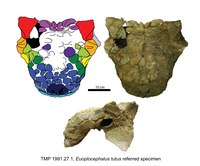 | |
| Panoplosaurus | P. mirus | Middle, 75.6 Ma ago[10] | Skull with lower jaws, isolated teeth, cervical vertebrae, dorsal vertebrae, sacral vertebrae, cervical ribs, dorsal ribs, scapulocoracoid, humerus, manus, tibia, fibula, ossified intersternal plate, a pair of ossified xiphoid processes, pes, and in situ osteoderms.[19] | A nodosaurine nodosaurid |  | |
| Platypelta | P. coombsi | Lower, 77.5-76.5 Ma ago[18] | A well-preserved skull, mandibles, teeth, cervical and dorsal vertebrae, ribs, complete pelvis, both scapulocoracoids, both humeri and radii, both cervical half-rings, and osteoderms.[18] | An ankylosaurine ankylosaurid |  | |
| Scolosaurus | S. cutleri | Lower, 76.5 Ma ago or more[11] | A nearly complete skeleton, a skull, cervical, dorsal, and caudal vertebrae, ribs, scapula, coracoid, humeri, radii, ilium, ischium, femur, tibia, fibula, [one] cervical half-ring, and osteoderms.[18] | An ankylosaurine ankylosaurid briefly thought to be synonymous with Euoplocephalus. It possibly came from the upper layers of the underlying Oldman Formation.[20] |  | |
| S. thronus | Upper, 75 Ma ago | A partial skeleton including a skull, dorsal vertebrae, ?complete synsacrum, sacral ribs, caudal vertebrae, scapula, partial ilia, humerus, cervical half-rings, osteoderms, and skin impressions.[18] | An ankylosaurine ankylosaurid | |||
Ceratopsians
An unnamed Pachyrhinosaurus-like taxon has been recovered from the formation.[21]
Ceratopsians from the Dinosaur Park Formation
| ||||||
|---|---|---|---|---|---|---|
| Genus | Species | Location | Stratigraphic position | Material | Notes | Images |
| Centrosaurus | C. apertus | Middle, 76.2-75.5Ma ago[10] | "[Fifteen] skulls, several skeletons, all adult; abundant bone-bed material with rare juveniles and subadults."[22][23] C. nasicornis may be a synonym. | A ceratopsid
|
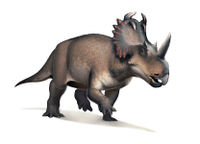 | |
| Chasmosaurus | C. belli | Middle, 76–75.5Ma ago[10] | "[Twelve] skulls, several skeletons."[22] | A chasmosaurine ceratopsid
|
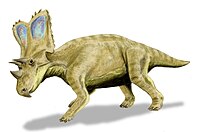 | |
| C. russelli | Lower, 76.5-76Ma ago[10] | "[Six] complete or partial skulls."[24] | ||||
| Mercuriceratops | M. gemini[25] | Lower, ~77Ma ago[25] | "one apomorphic squamosal"[25] | A chasmosaurine ceratopsid |  | |
| Monoclonius | M. lowei | A dubious centrosaurine ceratopsid. Possibly synonymous with Centrosaurus. | ||||
| Pentaceratops[26] | P. aquilonius[26] | Uppermost, 74.8 MA[26] | two frill fragments[26] | A dubious chasmosaurine ceratopsid that may be the same species as Spiclypeus shipporum.[27]
|
 | |
| Spinops[28] | S. sternbergorum[28] | Lower, 76.5Ma[28] | "partial parietal bone, partial dentary, unidentifiable limb fragments, partial skull, and partial right squamosal."[28] | A centrosaurine ceratopsid.It may actually be from the upper Oldman Formation.[28] |  | |
| Styracosaurus | S. albertensis | Upper, 75.5-75.2Ma ago[10] | "[Two] skulls, [three] skeletons, additional material in bone beds."[22] | A centrosaurine ceratopsid |  | |
| Unescoceratops | U. koppelhusae | Partial lower jaw[29] | A leptoceratopsid thought to have been between one and two meters long and less than 91 kilograms. Its teeth were the roundest of all leptoceratopsids.
|
|||
| Vagaceratops | V. irvinensis | Upper, 75Ma ago[10] | "[Three] skulls, skeleton lacking tail."[24] | A chasmosaurine ceratopsid species previously classified as a species of Chasmosaurus.[30] |  | |
Ornithopods
At least one indeterminate
In a 2001 review of hadrosaur eggshell and hatchling material from the Dinosaur Park Formation, Darren H. Tanke and M. K. Brett-Surman concluded that hadrosaurs nested in both the ancient upland and lowlands of the formation's depositional environment.[31] The upland nesting grounds may have been preferred by the less common hadrosaurs, like Brachylophosaurus or Parasaurolophus. However, the authors were unable to determine what specific factors shaped nesting ground choice in the formation's hadrosaurs. They suggested that behavior, diet, soil condition, and competition between dinosaur species all potentially influenced where hadrosaurs nested.[32]
Sub-centimeter fragments of pebbly-textured hadrosaur eggshell have been reported from the Dinosaur Park Formation. This eggshell is similar to the hadrosaur eggshell of
In contrast with eggshell fossils, the remains of very young hadrosaurs are actually somewhat common.
Ornithopods from the Dinosaur Park Formation
| ||||||
|---|---|---|---|---|---|---|
| Genus | Species | Location | Stratigraphic position | Material | Notes | Images |
| Corythosaurus | C. casuarius | Lower-Middle, 76.5-75.5Ma ago[10] | "Approximately [ten] articulated skulls and associated postcrania, [ten to fifteen] articulated skulls, isolated skull elements, juvenile to adult."[36] | A hadrosaur
|
 | |
| Gryposaurus | G. notabilis | Lower, 76.2-76Ma ago[10] | "Approximately [ten] complete skulls, [twelve] fragmentary skulls, associated postcrania."[37] | A saurolophine hadrosaur
|
 | |
| Lambeosaurus | L. lambei | Upper, 75.5-75Ma ago[10] | "Approximately [seven] articulated skulls with associated postcrania, [possibly ten] articulated skulls, isolated skull elements, juvenile to adult."[38] |  | ||
| L. magnicristatus | Upper/Bearpaw Formation, 74.8Ma ago[10] | "[Two] complete skulls, one with associated, articulated postcrania."[38] | 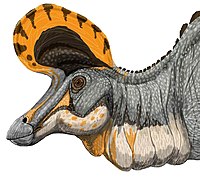 | |||
| Parasaurolophus | P. walkeri | Lower, 76.5-75.3Ma ago[8] | "Complete skull and postcranial skeleton."[38] | A parasaurolophin lambeosaurine hadrosaur.
|
 | |
| Prosaurolophus | P. maximus | Upper, 75.5 – 74.8 Ma | "[Twenty to twenty-five] individuals, including at least [seven] articulated skulls and associated postcrania."[37] | A saurolophin saurolophine hadrosaur | 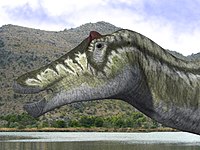 | |
Pachycephalosaurs
Pachycephalosaurs from the Dinosaur Park Formation
| ||||||
|---|---|---|---|---|---|---|
| Genus | Species | Location | Stratigraphic position | Material | Notes | Images |
|
F. brevis |
Also present in the Oldman Formation |
Frontoparetal dome, various other skull fragments including juvenile and subadult material |
Once thought to be a species of Stegoceras |
|||
|
G. albertae |
"Frontoparietal dome."[39] |
Potentially synonymous with Stegoceras validum.[40] |
 | |||
|
H. sternbergi |
Lower, also present in the Oldman Formation and Judith River Formation |
Potentially synonymous with Stegoceras validum.[40] |
 | |||
|
S. lyonsi[41] |
Upper, 76.10 ± 0.5 Ma[41] |
Right squamosal[41] |
||||
|
S. validum |
Specimens including frontoparietal dome.[39] |
 | ||||
|
" |
A nomen nudum. |
|||||
Theropods
In the Dinosaur Park Formation, small theropods are rare due to the tendency of their thin-walled bones to be broken or poorly preserved.[42] Small bones of small theropods that were preyed upon by larger ones may have been swallowed whole and digested.[43] In this context, the discovery of a small theropod dinosaur with preserved tooth marks was especially valuable.[42] Possible indeterminate avimimid remains are known from the formation.
Ornithomimids
Ornithomimids from the Dinosaur Park Formation
| ||||||
|---|---|---|---|---|---|---|
| Genus | Species | Location | Stratigraphic position | Material | Notes | Images |
| Ornithomimus | O. sp.[44] | Type specimen | An ornithomimid, possibly a species of Struthiomimus.[45]
|
 | ||
| Qiupalong | Q. sp.[46] | Several specimens | An ornithomimid, possibly a radiation of this genus from Asia.[46]
|
 | ||
| Rativates | R. evadens | Type specimen | An ornithomimid, formerly a specimen of Struthiomimus.[47] |  | ||
Oviraptorosaurs
Color key
|
Notes Uncertain or tentative taxa are in small text; |
Oviraptorosaurs from the Dinosaur Park Formation
| ||||||
|---|---|---|---|---|---|---|
| Genus | Species | Location | Stratigraphic position | Material | Notes | Images |
| Caenagnathus | C. collinsi | Mandible, type specimen | A caenagnathid[48] which rivalled Anzu in size.[49] | 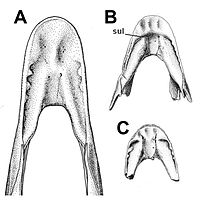 | ||
| Chirostenotes | C. pergracilis | Several fragmentary specimens, type specimen
|
A mid-sized caenagnathid. |  | ||
| Citipes | C. elegans[49] | Several fragmentary specimens, type specimen
|
Smallest caenagnathid from the formation.[49] |  | ||
Macrophalangia
|
M. canadensis | Junior synonym of Chirostenotes pergracilis | ||||
Paravians
A new taxon of troodontid based solely on teeth is known from the upper part of the formation.[50]
Paravians from the Dinosaur Park Formation
| ||||||
|---|---|---|---|---|---|---|
| Genus | Species | Location | Stratigraphic position | Material | Notes | Images |
| cf. Baptornis | Indeterminate | A hesperornithine bird
|
||||
| cf. Cimolopteryx | Indeterminate | Partial coracoid | A possible charadriiform bird | |||
| Dromaeosaurus | D. albertensis | Several specimens and teeth, type specimen
|
A dromaeosaurid |  | ||
| Hesperonychus | H. elizabethae | Hip bones and partial toes and claws, type specimen
|
A microraptorine dromaeosaur, also found in the Oldman Formation |  | ||
| Latenivenatrix | L. mcmasterae | Hip bones, pelvis, skull fragments, type specimen
|
A large troodontid measuring 3–3.5 m (9.8–11.5 ft).
|
 | ||
| cf. Palintropus | Unnamed | Partial shoulder girdles | An ambiortiform bird | |||
| cf. Paronychodon | cf. P. lacustris | Teeth | An indeterminate maniraptoran, also found in the Judith River | |||
| cf. Pectinodon[51] | Indeterminate | Teeth | A troodont | |||
| Polyodontosaurus | P. grandis | Dentary, type specimen
|
Nomen dubium. Possibly synonymous with Latenivenatrix. | |||
| Richardoestesia | R. gilmorei | type specimen
|
A dromaeosaurid | |||
| R. isosceles[50] | Teeth | |||||
| Saurornitholestes | S. langstoni | Incomplete skeleton and teeth, dentary referred to Saurornitholestes was discovered that preserved tooth marks left by a young tyrannosaur.[52]
|
A dromaeosaurid |  | ||
| Stenonychosaurus | S. inequalis | Nearly complete skeleton and other partial skeletons, type specimen
|
A troodontid once thought to be a species of Troodon |  | ||
Tyrannosaurs
Tyrannosaurs from the Dinosaur Park Formation
| ||||||
|---|---|---|---|---|---|---|
| Genus | Species | Location | Stratigraphic position | Material | Notes | Images |
| Daspletosaurus | Unnamed species[53] | Middle-Upper, 75.6-75Ma ago[10] | Several specimens | A tyrannosaurid, also present in the Bearpaw Formation .
|

| |
| Gorgosaurus | G. libratus | Lower-Middle, 76.6-75.1Ma ago[10] | Numerous specimens, type specimen[53]
|
An albertosaurine tyrannosaurid whose fossils have been unearthed in the Judith River Formation and possibly the Two Medicine Formation. It was the most common large carnivore in the area.[54] |  | |
Color key
|
Notes Uncertain or tentative taxa are in small text; |
Other reptiles
Choristoderes
- Champsosaurus (at least 3 species)
- Cteniogenys sp. cf. antiquus (possibly another genus)
Crocodylians
Remains of the following Crocodylians have been found in the formation:[56]
- Albertochampsa
- Leidyosuchus
- at least 1 unnamed taxon
Lizards
Remains of the following lizards have been found in the formation:[57]
- Helodermatids
- Necrosaurids
- Teiids
- Varanids
- Xenosaurids
Plesiosaurs
Remains of the following Plesiosaurs have been found in the formation:[58]
- Fluvionectes
- indeterminate polycotylids (shorter-necked)
Pterosaurs
Remains of the following pterosaurs have been found in the formation:[59]
- Cryodrakon [60] (known from small and large specimens)
- 1 unnamed non-azhdarchid pterosaur
Turtles
Remains of the following turtles have been found in the formation:[61]
- Adocus
- "Apalone"
- Aspideretoides (3 species)
- Basilemys
- Boremys
- Judithemys
- Neurankylus
- Plesiobaena
- 2 indeterminate taxa
Mammals
Remains of the following mammals have been found in the formation:[62]
- Multituberculata
- Cimexomys sp.
- Cimolodon spp.
- Cimolomys clarki
- Meniscoessus major
- Mesodma primaeva
- unnamed multituberculates
- Metatherians
- Alphadon halleyi
- Eodelphis browni
- E. cutleri
- 5 species of "Pediomys"
- Turgidodon russelli
- T. praesagus
- Eutherians
- Cimolestes sp. (uncertain taxonomy)
- Gypsonictops lewisi
- Paranyctoides sternbergi
- Unknown therians: at least 1 species
Fish
Remains of the following fish have been found in the formation:[63]
- Chondrichthyans
- Cretorectolobus olsoni (a carpet shark)
- Eucrossorhinus microcuspidatus (a carpet shark)
- sclerorhynchid)[64]
- Meristodonoides montanensis (a shark)
- Myledaphus bipartitus (a ray)
- Protoplatyrhina renae (a guitarfish)
- indeterminate orectolobid
- sturgeons)
- "Acipenser albertensis"
- Anchiacipenser acanthaspis[65]
- unnamed sturgeon
- unnamed paddlefish
- Holosteanfish
- Lepisosteus occidentalis (the gar)
- unnamed bowfin
- at least 2 other holosteans
- Teleost fish
- Belonostomus longirostris
- osteoglossomorph)
- Coriops amnicolus
- Estesesox foxi
- Oldmanesox
- Paralbula (including Phyllodus)
- elopomorph, like the tarpon)
- at least 8 other teleosts
Invertebrates
Remains of the following invertebrates have been found in the formation:[66]
- bivalves
- Freshwater gastropods
- Campeloma (2 species)
- Elimia
- Goniobasis(3 species)
- Hydrobia
- Lioplacodes (2 species)
Flora
Plant body fossils
The following plant body fossils have been found in the formation:[67]
- various ferns
- Equisetum (Equisetaceae)
- Gymnosperms
- Platyspiroxylon (Cupressaceae)
- Podocarpoxylon (Podocarpaceae)
- Elatocladus (Taxodiaceae)
- Sequoia (Taxodiaceae)
- Sequoiaxylon (Taxodiaceae)
- Taxodioxylon (Taxodiaceae)
- Ginkgos
- Angiosperms
- Artocarpus (Moraceae)
- Cercidiphyllaceae)
- Dombeyopsis (Sterculiaceae)
- Menispermites (Menispermaceae)
- Pistia (Araceae)
- Platanus (Platanaceae)
- Vitis (Vitaceae)
- Trapaceae)
Palynomorphs
- Unknown producers
- at least 8 species
- Fungi
- at least 35 taxa
- blue-green algae)
- at least 12 species
- dinoflagellates, a type of marine algae)
- unassigned cysts
- Bryophytes (mosses, liverworts, and hornworts)
- Anthocerotophyta(hornworts)
- at least 5 species
- Marchantiophyta (liverworts)
- at least 14 species
- Bryophyta (mosses)
- at least 5 species
- Lycopodiophyta
- club mosses)
- at least 11 species
- Selaginellaceae(small club mosses)
- at least 6 species
- quillworts)
- at least 1 species
- Polypodiophyta
- cinnamon ferns)
- at least 6 species
- climbing ferns)
- at least 20 species
- Gleicheniaceae (Gleichenia and allies; coral ferns)
- at least 5 species
- Cyatheaceae (Cyathea and allies)
- at least 4 species
- Dicksoniaceae (Dicksonia and allies)
- at least 3 species
- Polypodiaceae (ferns)
- at least 4 species
- Matoniaceae
- at least 1 species
- Marsileaceae
- at least 1 species
- Pinophyta (gymnosperms)
- Cycadaceae (cycads)
- at least 3 species
- Caytoniaceae
- at least 1 species
- Pinaceae (pines)
- at least 4 species
- Cupressaceae (cypresses)
- at least 3 species
- Podocarpaceae (Podocarpus and allies)
- at least 4 species
- Cheirolepidiaceae
- at least 2 species
- Mormon teas)
- at least 6 species
- Unknown gymnosperms: at least 3 species
- angiosperms)
- dicots)
- Buxaceae (boxwood)
- at least 1 species
- Gunneraceae (gunneras)
- at least 1 species
- quaking aspen)
- at least 1 species
- sundews)
- at least 1 species
- tallowwood)
- at least 2 species
- Loranthaceae (showy mistletoes)
- at least 1 species
- Sapindaceae (soapberry)
- at least 1 species
- Aceraceae (maples)
- at least 1 species
- Proteaceae (proteas)
- at least 9 species
- sunflowers)
- at least 1 species
- Fagaceae (beeches, oaks, chestnuts)
- at least 2 species
- Betulaceae (birches, alders)
- at least 1 species
- Ulmaceae (elms)
- at least 1 species
- goosefoots)
- at least 1 species
- Buxaceae (boxwood)
- monocots)
- lilies)
- at least 6 species
- Cyperaceae (sedges)
- at least 1 species
- bur-reeds)
- possibly 1 species
- Unknown angiosperms: at least 88 species
Timeline of new taxa
The following timeline displays valid taxa first discovered in the dinosaur park formation. Some species may have been referred to other genera subsequent to their initial description.

See also
- List of dinosaur-bearing rock formations
Footnotes
- ^ Lexicon of Canadian Geologic Units: Dinosaur Park Formation Archived 2013-02-21 at archive.today
- ^ doi:10.1139/e93-016.
- PMID 36163377.
- ^ ISBN 0-253-34595-2.
- ISBN 0-253-34595-2.
- .
- ^ Ryan and Evans (2005).
- ^ ]
- PMID 29166406.
- ^ S2CID 85665879.
- ^ .
- ^ Mallon, J. C., Evans, D. C., Ryan, M. J., & Anderson, J. S. (2012). Megaherbivorous dinosaur turnover in the Dinosaur Park Formation (upper Campanian) of Alberta, Canada. Palaeogeography, Palaeoclimatology, Palaeoecology.
- ISBN 0-253-34595-2.
- ^ "Fossilworks: Gateway to the Paleobiology Database". fossilworks.org. Retrieved 17 December 2021.
- ^ "Fossilworks: Gateway to the Paleobiology Database". fossilworks.org. Retrieved 17 December 2021.
- ISBN 0-253-34595-2.
- ISBN 0-253-34595-2.
- ^ .
- ^ "Table 17.1," in Weishampel, et al. (2004). Page 365.
- .
- ^ Ryan, Michael; Eberth, David; Brinkman, Donald; Currie, Philip; Tanke, Darren (January 2010). New Perspectives on Horned Dinosaurs. pp. 141–155. Retrieved 16 January 2022.
- ^ a b c "Table 23.1," in Weishampel, et al. (2004). Page 495.
- S2CID 130116586.
- ^ a b "Table 23.1," in Weishampel, et al. (2004). Page 496.
- ^ S2CID 13957187.
- ^ .
- PMID 27191389.
- ^ S2CID 13717580.
- .
- PMID 20877459.
- ^ a b "Abstract," Tanke and Brett-Surman (2001). Page 206.
- ^ "Conclusions," Tanke and Brett-Surman (2001). Page 212.
- ^ a b "Eggshell," Tanke and Brett-Surman (2001). Page 209.
- ^ "Introduction," Tanke and Brett-Surman (2001). Page 208.
- ^ "Discussion," Tanke and Brett-Surman (2001). Page 212.
- ^ "Table 20.1," in Weishampel, et al. (2004). Page 441.
- ^ a b "Table 20.1," in Weishampel, et al. (2004). Page 440.
- ^ a b c "Table 20.1," in Weishampel, et al. (2004). Page 442.
- ^ a b "Table 21.1," in Weishampel, et al. (2004). Page 465.
- ^ ISSN 2292-1389.
- ^ ISSN 2056-2799.
- ^ a b "Introduction," Jacobsen (2001). Page 59.
- ^ "Discussion," Jacobsen (2001). Page 61.
- .
- .
- ^ .
- S2CID 89242374.
- S2CID 128444961.
- ^ ISSN 2292-1389.
- ^ S2CID 85973327.
- PMID 23372708.
- ^ "Abstract," Jacobsen (2001). Page 58.
- ^ Currie, Philip J. (2003). "Cranial anatomy of tyrannosaurids from the Late Cretaceous of Alberta". Acta Palaeontologica Polonica. 48 (2): 191–226.
- ^ Yun, Changyu (January 2021). Fossil record 7: NMMNH Bulletin 82. New Mexico Museum of Natural History and Science. pp. 569–578. Retrieved 12 January 2022.
- ISBN 0-253-34595-2.
- ISBN 0-253-34595-2.
- ISBN 0-253-34595-2.
- ISBN 0-253-34595-2.
- ISBN 0-253-34595-2.
- S2CID 203406859.
- ISBN 0-253-34595-2.
- ISBN 0-253-34595-2.
- ISBN 0-253-34595-2.
- ^ "Fossilworks: Gateway to the Paleobiology Database". fossilworks.org. Retrieved 17 December 2021.
- S2CID 92574712.
- ISBN 0-253-34595-2.
- ISBN 0-253-34595-2.
- ISBN 0-253-34595-2.
References
- Arbour, V. M.; Burns, M. E.; Sissons, R. L. (2009). "A redescription of the ankylosaurid dinosaur Dyoplosaurus acutosquameus Parks, 1924 (Ornithischia: Ankylosauria) and a revision of the genus". Journal of Vertebrate Paleontology. 29 (4): 1117–1135. S2CID 85665879.
- Braman, D.R., and Koppelhus, E.B. 2005. Campanian palynomorphs. In: Currie, P.J., and Koppelhus, E.B. (eds), Dinosaur Provincial Park: A Spectacular Ancient Ecosystem Revealed. Indiana University Press: Bloomington and Indianapolis, 101–130.
- Brinkman, D.B. 2005. Turtles: diversity, paleoecology, and distribution. In: Currie, P.J., and Koppelhus, E.B. (eds), Dinosaur Provincial Park: A Spectacular Ancient Ecosystem Revealed. Indiana University Press: Bloomington and Indianapolis, 202–220.
- Caldwell, M.W. The squamates: origins, phylogeny, and paleoecology. In: Currie, P.J., and Koppelhus, E.B. (eds). 2005. Dinosaur Provincial Park: A Spectacular Ancient Ecosystem Revealed. Indiana University Press: Bloomington and Indianapolis, 235–248.
- Currie, P.J. 2005. Theropods, including birds. In: Currie, P.J., and Koppelhus, E.B. (eds), Dinosaur Provincial Park: A Spectacular Ancient Ecosystem Revealed. Indiana University Press: Bloomington and Indianapolis, 367–397.
- Currie, P.J., and Koppelhus, E.B. (eds). 2005. Dinosaur Provincial Park: A Spectacular Ancient Ecosystem Revealed. Indiana University Press: Bloomington and Indianapolis, 648 p.
- Eberth, D.A. 2005. The geology. In: Currie, P.J., and Koppelhus, E.B. (eds), Dinosaur Provincial Park: A Spectacular Ancient Ecosystem Revealed. Indiana University Press: Bloomington and Indianapolis, 54–82.
- Fox, R.C. 2005. Late Cretaceous mammals. In: Currie, P.J., and Koppelhus, E.B. (eds), Dinosaur Provincial Park: A Spectacular Ancient Ecosystem Revealed. Indiana University Press: Bloomington and Indianapolis, 417–435.
- K. Gao and Brinkman, D.B. 2005. Choristoderes from the Park and its vicinity. In: Currie, P.J., and Koppelhus, E.B. (eds), Dinosaur Provincial Park: A Spectacular Ancient Ecosystem Revealed. Indiana University Press: Bloomington and Indianapolis, 221–234.
- Gardner, J.D. 2005. Lissamphibians. In: Currie, P.J., and Koppelhus, E.B. (eds), Dinosaur Provincial Park: A Spectacular Ancient Ecosystem Revealed. Indiana University Press: Bloomington and Indianapolis, 186–201.
- Godfrey, S.J., and Currie, P.J. 2005. Pterosaurs. In: Currie, P.J., and Koppelhus, E.B. (eds), Dinosaur Provincial Park: A Spectacular Ancient Ecosystem Revealed. Indiana University Press: Bloomington and Indianapolis, 292–311.
- Johnston, P.A., and Hendy, A.J.W. 2005. Paleoecology of mollusks from the Upper Cretaceous Belly River Group. In: Currie, P.J., and Koppelhus, E.B. (eds), Dinosaur Provincial Park: A Spectacular Ancient Ecosystem Revealed. Indiana University Press: Bloomington and Indianapolis, 139–166.
- Koppelhus, E.B. 2005. Paleobotany. In: Currie, P.J., and Koppelhus, E.B. (eds), Dinosaur Provincial Park: A Spectacular Ancient Ecosystem Revealed. Indiana University Press: Bloomington and Indianapolis, 131–138.
- Lexicon of Canadian Geologic Units. "Dinosaur Park Formation". Archived from the original on 2013-02-21. Retrieved 2011-03-29.
- Neuman, A.G., and Brinkman, D.B. 2005. Fishes of the fluvial beds. In: Currie, P.J., and Koppelhus, E.B. (eds), Dinosaur Provincial Park: A Spectacular Ancient Ecosystem Revealed. Indiana University Press: Bloomington and Indianapolis, 167–185.
- Ryan, M.J., and Evans, D.C. 2005. Ornithischian dinosaurs. In: Currie, P.J., and Koppelhus, E.B. (eds), Dinosaur Provincial Park: A Spectacular Ancient Ecosystem Revealed. Indiana University Press: Bloomington and Indianapolis, 312–348.
- Sato, T., Eberth, D.A., Nicholls, E.L., and Manabe, M. 2005. Plesiosaurian remains from non-marine to paralic sediments. In: Currie, P.J., and Koppelhus, E.B. (eds), Dinosaur Provincial Park: A Spectacular Ancient Ecosystem Revealed. Indiana University Press: Bloomington and Indianapolis, 249–276.
- Tanke, D.H. and Brett-Surman, M.K. 2001. Evidence of Hatchling and Nestling-Size Hadrosaurs (Reptilia:Ornithischia) from Dinosaur Provincial Park (Dinosaur Park Formation: Campanian), Alberta, Canada. pp. 206–218. In: Mesozoic Vertebrate Life—New Research Inspired by the Paleontology of Philip J. Currie. Edited by D.H. Tanke and K. Carpenter. Indiana University Press: Bloomington. xviii + 577 pp.
- Xiao-Chun Wu. 2005. Crocodylians. In: Currie, P.J., and Koppelhus, E.B. (eds), Dinosaur Provincial Park: A Spectacular Ancient Ecosystem Revealed. Indiana University Press: Bloomington and Indianapolis, 277-291



